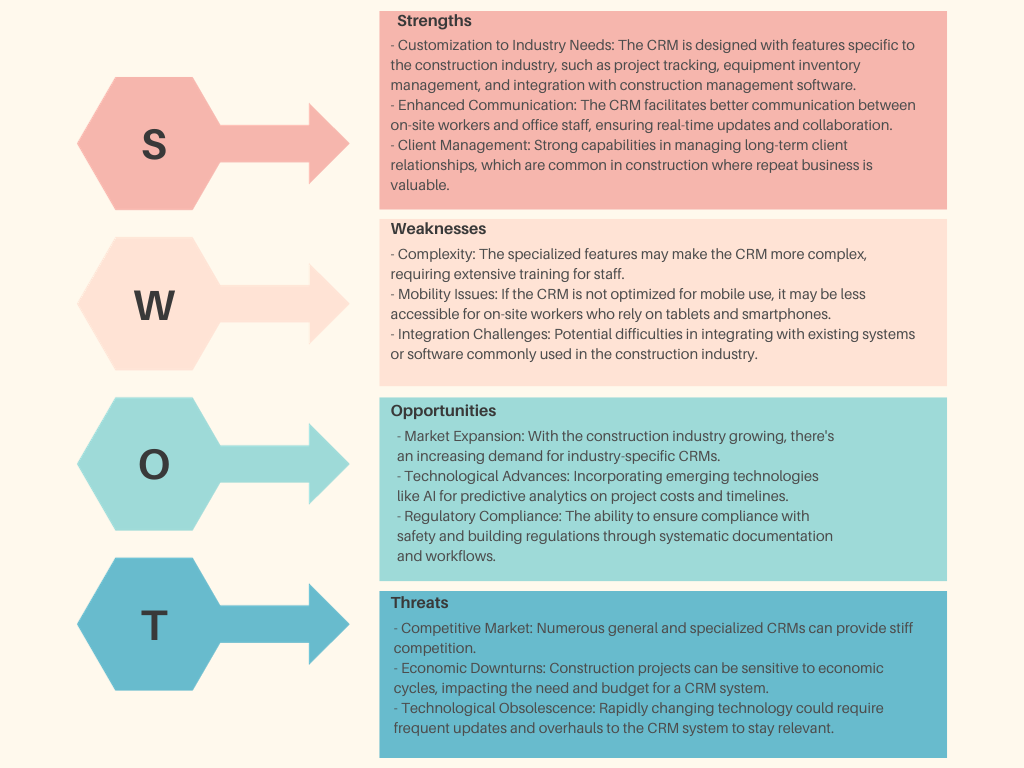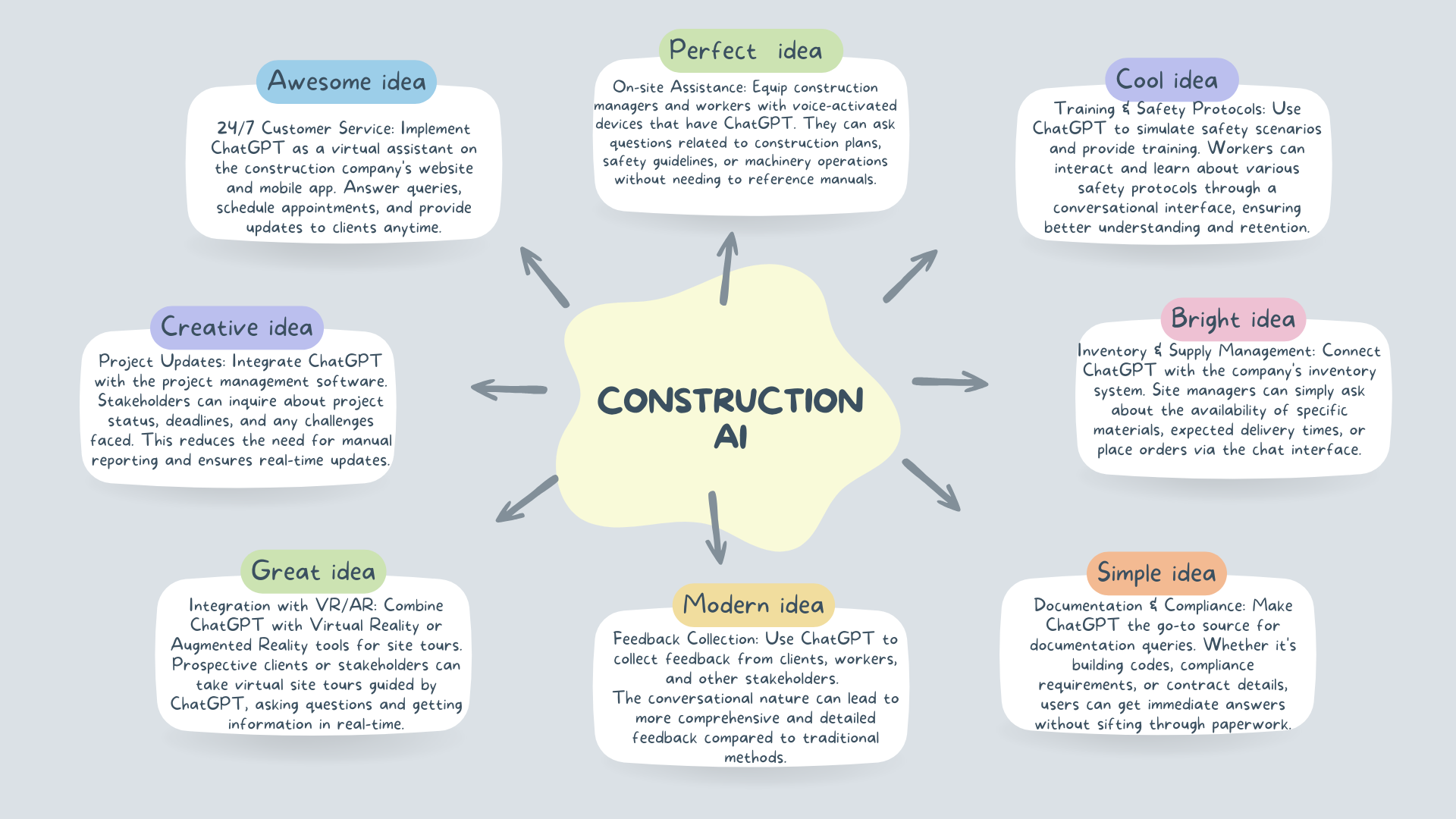SWOT Analysis for Construction CRM
Contents:
- Introduction to Construction CRM
- Strengths of Construction CRM
- Weaknesses of Construction CRM
- Opportunities in Construction CRM
- Threats Facing Construction CRM
- Strategies for Leveraging SWOT Analysis
In the intricate world of the construction industry, implementing a Customer Relationship Management (CRM) system is not just a technological upgrade; it's a strategic decision that can redefine how a company operates and engages with its clients.
The importance of conducting a SWOT analysis in this context cannot be overstated. This analytical tool provides construction companies with a clear, objective, and comprehensive view of their operational landscape.
It helps them navigate the complexities of CRM implementation by aligning their business strategies with actual internal capabilities and external market conditions.
For construction companies poised to enhance their customer relations and project management through advanced CRM solutions, a SWOT analysis stands as an essential first step, ensuring that the transition is not only smooth but also strategically sound and future-proof.
In general, a SWOT analysis is a strategic planning technique used to help identify Strengths, Weaknesses, Opportunities, and Threats related to business competition or project planning.
Here's a brief overview of what each section typically contains:

A SWOT analysis for a CRM system tailored for the construction industry could look like this:
-
Strengths:
-
Customization to Industry Needs: The CRM is designed with features specific to the construction industry, such as project tracking, equipment inventory management, and integration with construction management software.
-
Enhanced Communication: The CRM facilitates better communication between on-site workers and office staff, ensuring real-time updates and collaboration.
-
Client Management: Strong capabilities in managing long-term client relationships, which are common in construction where repeat business is valuable.
-
-
Weaknesses:
-
Complexity: The specialized features may make the CRM more complex, requiring extensive training for staff.
-
Mobility Issues: If the CRM is not optimized for mobile use, it may be less accessible for on-site workers who rely on tablets and smartphones.
-
Integration Challenges: Potential difficulties in integrating with existing systems or software commonly used in the construction industry.
-
-
Opportunities:
-
Market Expansion: With the construction industry growing, there's an increasing demand for industry-specific CRMs.
-
Technological Advances: Incorporating emerging technologies like AI for predictive analytics on project costs and timelines.
-
Regulatory Compliance: The ability to ensure compliance with safety and building regulations through systematic documentation and workflows.
-
-
Threats:
-
Competitive Market: Numerous general and specialized CRMs can provide stiff competition.
-
Economic Downturns: Construction projects can be sensitive to economic cycles, impacting the need and budget for a CRM system.
-
Technological Obsolescence: Rapidly changing technology could require frequent updates and overhauls to the CRM system to stay relevant.
-

This SWOT analysis outlines internal and external factors that could affect the success and adoption of a CRM system in the construction industry. It's an essential strategic tool that can help the company leverage its strengths, improve its weaknesses, capitalize on opportunities, and mitigate potential threats.
A SWOT analysis can play a pivotal role in each aspect of developing and implementing a Construction CRM system. Let's examine how it contributes to the who, what, when, where, why, and how of this process:
-
Who:
-
A SWOT analysis helps identify the key stakeholders who will benefit most from a Construction CRM, such as project managers needing real-time updates or sales teams requiring detailed client histories. By understanding strengths, you can tailor the CRM to enhance user strengths further, address weaknesses like potential training gaps, seize opportunities for greater user engagement, and mitigate threats such as user resistance to new technology.
-
-
What:
-
The analysis defines what the CRM must accomplish, aligning its features with the strengths of the business's services and internal processes. It reveals weaknesses in current systems that the CRM can solve, opportunities for new functionalities, and threats from competitors' offerings. This clarity ensures the CRM is developed with purposeful functionality that meets the industry's demands.
-
-
When:
-
Timing is critical for CRM implementation. A SWOT analysis can determine when a company is ready to transition, based on internal strengths such as team readiness or external opportunities like market demand. It also highlights weaknesses that may suggest delaying implementation and threats that could affect timing, like economic downturns.
-
-
Where:
-
The "where" pertains to the environmental context in which the CRM will operate. A SWOT analysis can help understand the geographic distribution of projects (strengths), areas with weaker network connectivity (weaknesses), regions with untapped potential clients (opportunities), and locations with high competitive presence (threats).
-
-
Why:
-
Understanding 'why' involves justifying the need for a Construction CRM. A SWOT analysis can elucidate the strengths that a CRM will bolster, such as improved customer retention, and the weaknesses it will address, like inefficiencies in data management. It also can reveal opportunities for growth that the CRM could unlock and external threats it may need to counteract, such as regulatory changes.
-
-
How:
-
Finally, the 'how' focuses on the strategy and execution. A SWOT analysis assists in formulating a roadmap for CRM integration by leveraging internal strengths, improving internal processes, capturing new market opportunities, and defending against technological obsolescence.
-
By conducting a SWOT analysis, construction companies can make informed decisions about the adoption of a CRM system. It provides a strategic framework that helps to maximize the CRM's impact on operations, marketing, sales, and customer service within the unique context of the construction industry.
For construction companies, the journey of implementing a CRM system is akin to laying the foundation for a skyscraper—it must be done with precision, foresight, and an understanding of the terrain.
A SWOT analysis provides the blueprint for such an undertaking, offering a high-level perspective that is both insightful and actionable.
By leveraging the insights gained from a SWOT analysis, construction companies can anticipate challenges, harness opportunities, and build a CRM strategy that is as robust and enduring as the structures they erect.
As the industry continues to evolve with digital transformations, a well-conducted SWOT analysis is not just an exercise in strategy; it is a cornerstone of competitive advantage and business resilience in the relentless pursuit of growth and excellence.
If you’re keen on joining our Fast-Track Program, click here to sign up. We’re excited to have you on board!